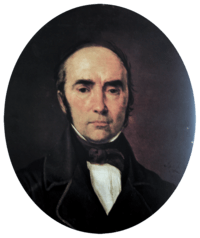Simonas Daukantas

.jpg)

Simonas Daukantas or Szymon Dowkont[2][3] (28 October 1793 – 6 December 1864) was a Lithuanian/Samogitian writer,[4] ethnographer and prose historian. One of the pioneers of the Lithuanian national revival, he is credited as an author of the first book on the history of Lithuania written in the Lithuanian language. He also published several books on Lithuanian and Samogitian folklore, and wrote a Polish-Lithuanian dictionary.[4] Daukantas wrote his historical works under the influence of the Romanticism of the time. Daukantas attributed whatever led to the downfall of the Lithuanian Village to the Polish nobility and the ruling class, which became self-interested and weak in adapting folk tales, songs, customs, costumes language and idioms of the Lithuanian people and their language. As an author he published under a variety of pen-names, including, Jakyb Łaukys, K.V.Mylė, Jokūbas Laukys[5] (Jokyb's Łaukys),[6] Motiejus Šauklys, J.Devynakis, Jonas Girdenis, Jonas Raganius, Antanas Žeimys, Jonas Purvys and Antanas Vaineikis, some of them mentioned also in Polonised form.
Biography
Daukantas, was born on October 26, 1793 in Kalviai, near Skuodas. In 1814 he went to Vilnius and entered a local gymnasium. After graduating in 1816, he began studies at Vilnius University, then known as The Imperial University of Vilna. In 1819 Daukantas received his first degree in the field of law, and in 1822, a Masters Degree also in law. Daukantas did not receive his diploma immediately due the suppression of the Filomat and Filaret student movements at Vilnius University; he received the diploma only in 1825. He then relocated to Dorpat (modern Tartu), where he continued his studies until moving to Riga. Daukantas worked as a translator at the Governor Council Office at Riga for ten years. From there, Daukantas moved to the Capital of Russia, St. Petersburg, and obtained employment at the Lithuanian Metrica Office, and assisted Franciszek Malewski and Franciszek Czarnocki until 1835 . Daukantas studied at the Senate Office Archives where important Lithuanian State documents were kept from the 15th to the 18th Century .[3] Daukantas collaborated with Teodor Narbutt, a historian, and gave him almost eight hundred original documents dealing with Lithuanian history as well as that of the Polish-Lithuanian Commonwealth.[2] He also published several history books and novels in Lithuanian, notably the Pałangos petris, a "Robinson Crusoe-like novel".[2] In 1846 fables by Phaedrus, (Lith. Pasakos Fedro) and Cornelius Nepos' work,De Viris Illustribus, (1846) were translated by Daukantas under the pen-name Motiejus Šauklys into the Lithuanian language and were published in St. Petersburg.[7] Among his manuscripts were a Polish-Lithuanian dictionary and a book on the history of Samogitia and Lithuania. Both were published posthumously.[2] Daukantas wrote in the Samogitian dialect and his writing style is characterized as picturesque,ornamental using apotheosis and colorful contrast to enrich the vocabulary of his writings which was usually rich,full of rare words and taken from old writings and folklore characteristic of the field of "Belle Letters". Finally in 1850 he returned to Lithuania, where he died on December 6, 1864. He was buried on the summit of the Papilė hill fort. A monument designed by Vincas Grybas was erected there in 1930. His place in Lithuanian history is also commemorated by Daukantas Square, facing the Presidential Palace in Vilnius.
Bibliography
- Darbai senųjų lietuvių ir žemaičių ,The Deeds of the ancient Lithuanians and Samogitians (1822);
- Istorija žemaitiška, The History of the Ancient Lithuanians (1838) USA ;
- Latin-Lithuanian little dictionary (Vilnius,1838);
- Būdas senovės lietuvių, kalnėnų ir žemaičių (original title Budą Senowęs Lietuwiû kalneniu ir Żemaitiû, The Character of the ancient Highlanders and Samogitians ; St. Petersburg, 1845);
- Daines Ziamajtiû , Samogitian Songs (118 folk songs) (St. Petersburg, 1846);
- Pasakojimas apie veikalus lietuvių tautos senovėje (St.Petersburg,1850);
- Pasakos Masiu ,The Tales of the Common People (96 folktales)(Vilnius, 1932);
- Rinktiniai Rastai, Selected Works (Vilnius, 1855)
- Pałangos petris
Notes
- ↑ Stefania Krzysztofowicz-Kozakowska; Janusz Kozina (2003). Malarstwo Polskie w zbiorach za granicą (in Polish). Kraków: Wydawnictwo Kluszczyński. ISBN 83-88080-85-7.
- 1 2 3 4 various authors (1899). "Dowkont Szymon". In Samuel Orgelbrand. S. Orgelbranda Encyklopedia Powszechna (in Polish). IV. Warsaw: S. Orgelbrand i Synowie. p. 455. Retrieved 2007-11-05.
- 1 2 Patricia Kennedy Grimsted; Irena Sułkowska-Kurasiowa (1984). The "Lithuanian Metrica" in Moscow and Warsaw: Reconstructing the Archives of the Grand Duchy of Lithuania. Warsaw: Institute of History of the Polish Academy of Sciences. ISBN 0-89250-340-8.
The study was carried out by Franciszek Malewski and assistants Franciszek Czarnocki and Szymon Dowkont.
- 1 2 Giedrius Subačius (June 2004). "Grafemos <ſ> netektis Lietuvos rankraſzčiuose" (pdf). Archivum Lithuanicum (in Lithuanian). Vilnius: Lietuvių Kalbos Institutas (6): 279. ISSN 1392-737X. Retrieved 2007-11-06.
- ↑ Senn, Alfred (1966). Handbuch der litauischen Sprache. p. 97.
- ↑ http://antologija.lt/scan_img/16.jpg
- ↑ Aušra Navickienė, Mikalojaus Akelaičio laiškai Adamui Zawadzkiui in KNYGOTYRA, 49. Vilnius 2007. ISSN 0204-2061.
Further reading
- Baar, Monika. Historians and Nationalism: East-Central Europe in the Nineteenth Century (2010) excerpt, pp 25–29 and passim
- (Lithuanian)S. Žukas. Simonas Daukantas. Kaunas, Šviesa, 1988. 182 p.
- (Lithuanian)V. Merkys. Simonas Daukantas. Vilnius, Vyturys, 1991. 212 p.
- "Simonas Daukantas". Lithuanian Classical Literature Anthology. Retrieved 2007-09-22.
External links
- (Lithuanian) BŪDAS SENOVĖS LIETUVIŲ, KALNĖNŲ IR ŽEMAIČIŲ
- Baltisches biographisches Archiv [microform]: BaBA/[advising editor, Paul Kaegbein;editor, Axel Freyl. Published: Munchen:K.G.Saur Verlag,[1995-1998]